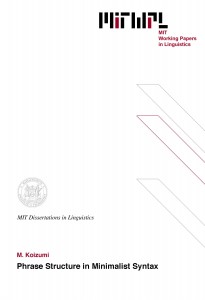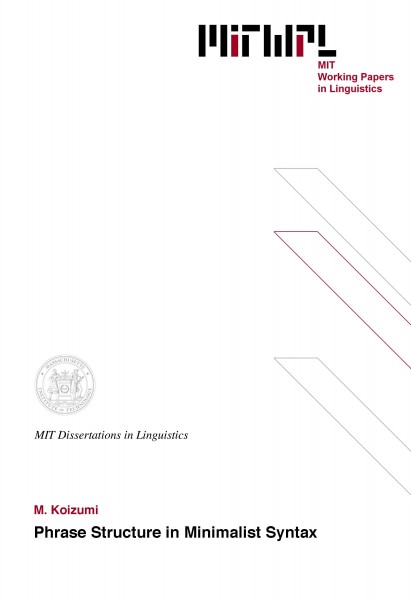Phrase Structure in Minimalist Syntax
M. Koizumi, 1995
This thesis is a study of clause architecture within a theory of generative grammar. It discusses four major syntactic hypotheses that have crucial bearing on the design of phrase structure: the Agreement-based Case theory, the internal subject hypothesis (ISH), the uniform three-level X-bar theory, and a hypothesis about string vacuous head movement.
In Chapter 2 through Chapter 4, I discuss object positions in three typologically and genetically different languages, i.e. English, Zarma, and Japanese, and argue that they all possess Object Agreement Phrases (AGRoP). A consideration of learnability suggests that the presence of AGRoP in these languages, particularly in Japanese, is not learnable from the data available to children. Thus, it is highly likely that UG is so construed that every language has AGR (The Universal AGR Hypothesis).
In Chapter 5, I turn to subject positions. There is conflicting evidence regarding the base-position of the external argument. Some data indicate that the external argument originates in a position lower than its surface position, as is expected under the internal subject hypothesis. Other data suggest that the base-position of the external argument is outside AGRoP and the VP that dominates the main verb and the internal arguments. If the ISH is correct in that all arguments of a predicate category (e.g. V) originate within the maximal projection of this category, then the apparently contradicting data suggest that there are two verbs, hence two VPs, in a single clause (The Split VP Hypothesis). One verb is above AGRoP, and the other is below AGRoP. The so-called external argument is an argument of the upper V, and "internal arguments" are arguments of the lower V.
Chapter 6 is concerned with X-bar theory. I argue, contrary to the wide held view, that some functional categories allow more than one specifier position within their projections (Layered Specifiers), and that the number of specifiers is different across categories. If this is correct, the X-bar schema as such cannot be a part of Universal Grammar, as already suggested by Fukui (1986) and others. Our claim, however, is crucially different from Fukui"s (1986) in that the specifiers of functional categories do not necessarily (but sometimes do) "close off" their projections.
In Chapter 7, I discuss string vacuous cerb raising in head final languages. In particular, I present evidence that verbs in Japanese raise out of the VP in overt syntax. Its consequences are also explored to various aspects of syntactic theory such as the Proper Binding Condition, Kayne"s (1994) Linear Correspondence Axiom, etc.
Thesis Supervisor: Noam Chomsky
Title: Institute Professor
Table of Contents
Chapter One Introduction 9
1 Outline of the thesis 9
Chapter Two Invisible AGR in English 15
1 Case adjacency effects 16
2 Deriving the adjacency condition 26
3 The ECM construction 31
4 The double object construction 37
5 Some differences between English and French 41
Chapter Three Invisible AGR in Zarma 47
1 Basic word orders 47
2 Adverb placement 52
3 The double object construction 57
Chapter Four Invisible AGR in Japanese 59
1 Syntactic compounds 59
1.1 Raising vs. Control 60
1.2 Stative compounds 66
2 A Minimalist account 70
2.1 Three-layered case theory 71
2.2 Derivations 74
3 Alternative analyses 78
3.1 Quantifier raising 79
3.2 Complex control predicates as lexical compounds 81
4 Consequences 84
4.1 Control predicates without accusative Case-features 84
4.2 Tensed embedded clauses 87
4.3 Multiple embedding 88
4.4 Causative constructions 90
5 Conclusion 97
Chapter Five The Split VP Hypothesis 99
1 A split VP hypothesis 101
2 Motivations for the split VP hypothesis 105
2.1 Quantifier float 105
2.2 Relativized minimality 110
2.3 Participle agreement 113
2.4 Chain condition 115
3 Arguments for the internal subject hypothesis revisited 119
3.1 Simplification of q"marking 119
3.2 INFL as a raising category 120
3.3 VP coordination 121
3.4 Reconstruction effects 122
3.5 Quantifier float 123
4 Can the domain extension convention be eliminated? 125
5 Conclusion 129
Appendix to Chapter Five: related proposals 129
Chapter Six Layered Specifiers 137
1 Double-layered specifiers 138
1.1 Topicalization in English 138
1.2 Embedded V2 147
2 Multiply-layered specifiers 152
2.1 Multiple WH fronting 153
2.2 Multiple subjects 158
3 Double-multiply-layered specifiers 160
4 Conclulsion 163
Chapter Seven String Vacuous Overt Verb Raising 165
1 Overt verb raising in Japanese 166
1.1 Clefting 166
1.2 Coordination 170
2 Apparent alternative analyses 174
2.1 Gapping 174
2.2 Right-node-raising 176
3 Consequences 178
3.1 Restructuring 178
3.2 Complex predicate formation 181
3.3 Proper binding condition 185
3.4 Multiple long-distance scrambling as remnant scrambling 194
3.5 Are floating quantifiers floating? 197
3.6 Is Japanese SVO? 201
4 Conclusion 203
Appendices to Chapter Seven 204
A. Numeral quantifiers and the conjunctive particle 204
B. On the uncleftability of the lower VP in English 207
C. Traces not created by movement 209

